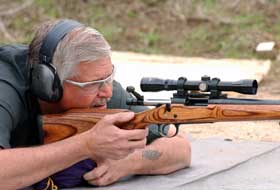I've been thinking lately about that ole debil "task loading," or, why multitasking is a myth. What got me started on this was an interesting thing that happened while I was at Gunsite. I was on my gazillionth run at the Scramble course, and we were down to filming the "cutaways," breaking each shooting position down into its component parts and filming them to allow the editors something to "cut away" to...movie magic blah blah stuff, doncha know.
Erik Olds, the Gunsite instructor, said, "Your finger's going in the trigger guard before you're in position to shoot." Happened twice. That's not something I normally ever do. I mean, I've shot several hundred matches over the last 30 years — handgun, rifle, shotgun, three-gun, cowboy, submachinegun, fill-in-the-blank — run high-speed simulations and helped hammer out safety issues for matches years and years ago. If you were to ask me, I'd say I have completely internalized trigger discipline. Rule 3: Don't put your finger on the trigger until you're ready for the gun to go bang. I didn't touch the trigger, but I was going into the trigger guard too soon.
I realized that task loading had reared its ugly head!
The "rule" of task loading states simply that the more tasks you're asked to perform, the less likely you are to perform all tasks well. Task loading appears (to me) to follow a geometric rather than an arithmatic progression. Imagine a graph where the horizontal axis is "numbers of tasks" and the vertical axis is an inverse "quality of performance;" that is, where the vertical axis meets the horizontal axis is "100% performance," a.k.a. perfect performance. The higher you go on the vertical axis, the worse your performance per task gets.
An arithmatic progression would yield a straight line whose steepness would be relative how much performance-per-task degraded as additional tasks were added. A geometric progression is a up-turning curve, with performance-per task drastically declining as additional tasks are added. My observation of and experience with task loading both in firearms instruction and instruction for high-risk sports such as technical diving or climbing Big Mountains is that not only does it follow a geometric progression, but there is a "crash point," where basically everything goes to hell and you can't do anything...very bad in a risky situation!
Cave divers are real big on task loading, sensitive to even small tasks that are "no problemo" when taken individually but which add to the overall load. My cave diving instructor was big on the idea that the complexity of the tasks added didn't really make that much difference — a simple task was every bit as big a load as a compex task. It was the additive nature that made task loading so dangerous.
So why am I harping on this? Because it's not something we normally think about and it's sneaky as hell. Task loading goes against our common sense, which tells us that several small, non-complex tasks taken as a group should not be a big issue. Then we drive our SUV into a tree we've driven past safely a thousand times.
Here's my example of task loading — I run into the frame, assuming exactly the same shooting position as when I was running the course for real. Making sure my hands and the gun are in the same position, I take — and make — the shot, then exit the frame the same way I did it for real. Oh yeah, there are two cameramen in awkward positions I have to make sure I don't sweep when I exit while keeping the muzzle downrange...etc.
John Shaw, who founded the Mid-South Institute for Self-Defense Shooting, had the best analogy I've ever heard about task loading (although he didn't use it in that context). Imagine, John said, that everyone gets $1 worth — 100 pennies — of concentration. That's it. Nobody gets a buck and a quarter; no matter how many Tony Robbins' seminars you attend, you've still only got those 100 pennies of concentration. Your only option is how to spend those pennies.
John goes on to talk about focus, but the analogy works perfect for task loading. Every task requires a few pennies — I suspect a minimum amount of, say, a nickel's worth. Whenever we add a task, we subtract from our 100 pennies available. Even an inconsequential task takes five pennies. The closer we get to "spending" all 100 pennies, the closer we come to the "crash point."
And even if we're a ways away from the crash point, as we add tasks we're still drastically degrading our performance of each task.
There are some interesting implications for tactical training here (jeeez, as well as for the Real World!). I have seen a trend in training that involves adding "simple" tasks, largely as a way to differentiate one person's training style from another. The true secret way of the Ninja involves standing on one foot, chanting while drawing the knife, etc.
If each task added degrades performance of all tasks — including the primary task of saving one's ass — I would say the existance of task loading argues for simplicity. Plus, it requires a certain level of vigilance from all of us, no matter how experienced, to keep it from sneaking up and biting our posteriors!!
Monday, March 14, 2005
Subscribe to:
Post Comments (Atom)






5 comments:
Keith Code, motorcycle training Guru, has you spending $10 instead. Same idea. However, what he adds is that after repetition / training you can spend less of your money on X task. For example, a beginning rider needs to spend a lot of the $10 on simply operating the motorcyle: balance, working the controls, etc. As experence grows, spending more of that $10 on other things, like bike placement, traction limits, etc.
I've read about professional riders talking about the correct race line through a corner and being a few INCHES off. I just hope to be in the correct area.
I've also heard of this as events slowing down, people able to remember an abnormal level of detail. On the other hand, I've read of tunnel vision, where one has to concentrate directly in front of them (isn't there something about this in a gunfight were you focus on your opponent, and not your sights/gun?) and 'lose track' of hearing and peripheral vision.
Overload in Colorado
Good ole adrenalin time dilation! I once pitched a kayak (with myself in it) off a three-story waterfall in New Zealand. It took, like, two YEARS to fall down that face. I coulda called out for pizza and had it delivered. The cool thing about the time dilation is that you can function inside it with practice. Time is a precious thing in those kinds of situations, and even part of a second is the difference between living and dying.
The narrowing of the senses — vision, hearing — is classic predator stuff...focus on the threat or focus on dinner, but FOCUS. It takes a conscious effort to pull yourself out of the tunneling, which is important in a self-defense context where the threats may be OUTSIDE the tunnel. Both times I have drawn a gun on a human being (and I use the term loosely), I very specifically remember the front sight and a point just below the targets' noses. Both times I remember it being very quiet and still (auditory exclusion/tunneling). THANKFULLY, I didn't have to pull the trigger!!!
In truth, regular practice allows you to focus less on repetitive tasks, but I think task loading has the power to override even drilled-in programming (though I assume...never a good idea...that it would take more tasks loaded on for such an override to occur.
mb
I shot an IPSC match last weekend, where I ended up 3rd overall on the first stage, then 6th overall on the 2nd stage.
Unfortunately, I had changed magazine springs and base-pads on a couple of my magazines, and they chose to jam the gun real good after the day warmed up.
From that point on, I was so distracted by the possibility of a jam, and the complex series of corrective actions I would take in response, that I completely forgot about such elementary considerations as "Front Sight - PRESS!"
It doesn't have to be a sufvival situation for overload to occur. All it requires for me to perform at a drastically lower level of achievement is to have ONE more thing added to the pressure already generated by the need for gun safety, gun-handling skills (grip, etc.), accuracy, time ... well, you've been there Michael, you know the drill.
When you're running close to the edge, you can't afford to allow yourself to be distracted.
What you say, is gospel. The best you can do is use practice and preparation to minimize extraneous factors, and depend on your experience and training to get you past the 'brain farts'.
And yes, while I was dealing with the atypical mechanical problems, I COULD have sent out for pizza, and had it delivered, but I would have got the order wrong because I was trying to do too many things at once.
Really helpful data, lots of thanks for the post.
I saw so much useful data in this post!
Post a Comment